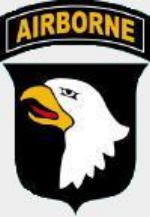Forces of Valor FOV821004A US Army Boeing-Vertol CH-47D Chinook Heavy Lift Helicopter - A Company, 7th Battalion, 101st Airborne Division "Screaming Eagles", Afghanistan, 2003 (1:72 Scale)
"The Chinook is an awesome aviation airframe. It is able to lift single heavy-duty pieces of equipment and light vehicles and is one of the most reliable airframes in service in the entire United States Military. It can lift up to 50,000 pounds and nearly 26,000 can be slung below the helicopter from the center hook. It has redundancy built in that many people do not even realize, which makes it a very safe airframe. Each of the huge rotor blades on the Chinook CH-47 weighs 350 pounds, and the engines work together to turn the rotors. Each of the engines work about 50 percent capacity, if one engine fails the other simply goes into high gear, and functions at 100 percent allowing the helicopter to fly just as well as it does with two engines."
- Military.com
 The CH-47 is a twin-engine, tandem rotor helicopter designed for transportation of cargo, troops, and weapons during day, night, visual, and instrument conditions. Development of the medium lift Boeing Vertol (models 114 and 414) CH-47 Series Chinook began in 1956. Since then the effectiveness of the Chinook has been continually upgraded by successive product improvements, the CH-47A, CH-47B, CH-47C, and CH-47D. The amount of load a cargo helicopter can carry depends on the model, the fuel on board, the distance to be flown, and atmospheric conditions.
The CH-47 is a twin-engine, tandem rotor helicopter designed for transportation of cargo, troops, and weapons during day, night, visual, and instrument conditions. Development of the medium lift Boeing Vertol (models 114 and 414) CH-47 Series Chinook began in 1956. Since then the effectiveness of the Chinook has been continually upgraded by successive product improvements, the CH-47A, CH-47B, CH-47C, and CH-47D. The amount of load a cargo helicopter can carry depends on the model, the fuel on board, the distance to be flown, and atmospheric conditions.
The CH-47D shares the same airframe as earlier models, the main difference being the adoption of more powerful engines. Early CH-47Ds were originally powered by two T55-L-712 engines, the most common engine is the later T55-GA-714A. With its triple-hook cargo system, the CH-47D can carry heavy payloads internally and up to 26,000 pounds (12 t) (such as 40-foot or 12-metre containers) externally. It was first introduced into service in 1979. In air assault operations, it often serves as the principal mover of the 155 mm M198 howitzer, accompanying 30 rounds of ammunition, and an 11-man crew. The CH-47D also has advanced avionics, such as the Global Positioning System. Nearly all US Army CH-47D were conversions from previous A, B, and C models, a total of 472 being converted. The last U.S. Army CH-47D built was delivered to the U.S. Army Reserve, located at Fort Hood, Texas, in 2002.
The Netherlands acquired all seven of the Canadian Forces' surviving CH-147s and upgraded them to CH-47D standard. Six more new-build CH-47Ds were delivered in 1995 for a total of 13. The Dutch CH-47Ds feature a number of improvements over U.S. Army CH-47Ds, including a long nose for Bendix weather radar, a "glass cockpit", and improved T55-L-714 engines. As of 2011, the Netherlands shall upgrade 11 of these which will be updated to the CH-47F standard at a later date. As of 2011, Singapore has 18 CH-47D/SDs, which includes twelve "Super D" Chinooks, in service. In 2008, Canada purchased 6 CH-47Ds from the U.S. for the Canadian Helicopter Force Afghanistan for $252 million. With 1 CH-47D loss, the remaining 5 CH-47D were returned by Canada in 2011 after their mission in Afghanistan was over.
Pictured here is a 1:72 scale replica of a US Army Boeing-Vertol CH-47 Chinook helicopter that was attached to A Company, 7th Battalion, 101st Airborne Division "Screaming Eagles", then deployed to Afghanistan during 2003.
Sold Out!
Dimensions:
Length: 9-inches
Rotorspan: 10-inches
Release Date: December 2018
 Historical Account: "Yeoman Service" - Approximately 163 CH-47Ds served in Kuwait and Iraq during Operations Desert Shield and Desert Storm in 1990-91.
Historical Account: "Yeoman Service" - Approximately 163 CH-47Ds served in Kuwait and Iraq during Operations Desert Shield and Desert Storm in 1990-91.
The CH-47D has seen wide use in Operation Enduring Freedom in Afghanistan and Operation Iraqi Freedom in Iraq. The Chinook is being used in air assault missions, inserting troops into fire bases and later bringing food, water, and ammunition. It is also the casualty evacuation (casevac) aircraft of choice in the British Armed Forces. In today's usage it is typically escorted by attack helicopters such as the AH-64 Apache for protection. Its tandem rotor design and lift capacity have been found to be particularly useful in the mountainous terrain of Afghanistan where high altitudes and temperatures limit the use of the UH-60 Black Hawk. The CH-47F is being fielded by more units such as the 101st Combat Aviation Brigade and 4th Combat Aviation Brigade in the U.S. Army as it continues to operate in Afghanistan.
The Chinook helicopters of several nations have participated in the Afghanistan War, including aircraft from Britain, Italy, the Netherlands, Spain, Canada, and Australia. Despite the age of the Chinook, it is still in heavy demand, in part due its proven versatility and ability to operate in demanding environments such as Afghanistan.
On August 6th, 2011, a Chinook crashed near Kabul killing all of the 38 aboard. It was reportedly shot down with a rocket-propelled grenade by the Taliban. The 38 were members of NATO and allied forces, including about 30 U.S. special forces and seven Afghan troops. The previous biggest single-day loss for American forces in Afghanistan involved a Chinook that was shot down near Kabul in Kunar Province in June 2005, with the death of all aboard, including a 16-member U.S. Special Operations team.





 CH-47D Chinook
CH-47D Chinook 



 Chinook
Chinook